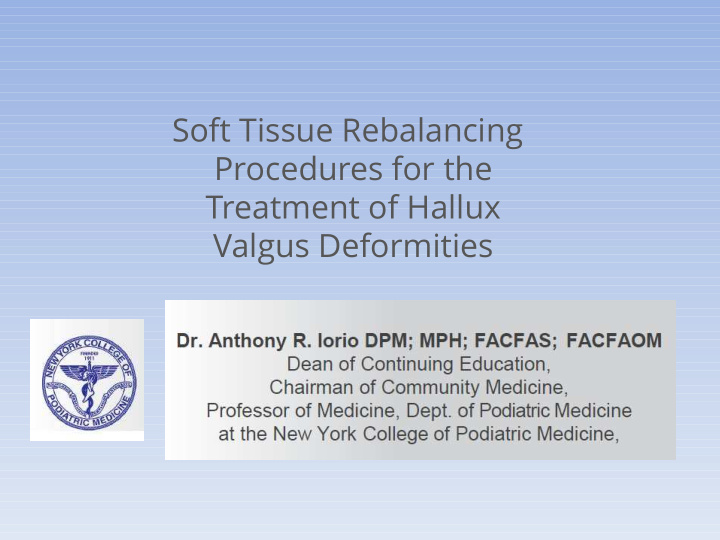



Soft Tissue Rebalancing Procedures for the Treatment of Hallux Valgus Deformities
NO DISCLOSURES
Objectives The main objectives of any procedure in hallux abducto • valgus surgery are to correct the deformity, prevent recurrence, and maintain as nearly normal motion Discuss Historical Perspective of Soft Tissue Procedure(s) for • Hallux Abducto Valgus Review Sequential Soft Tissue Rebalancing procedure(s) for • Hallux Valgus Interpretation of the results of soft tissue rebalancing • procedures described in a study are a viable option to adequately correct severe hallux valgus deformities, when certain factors dictate that an osteotomy should not be performed.
Historical Perspective
Historical Perspective 1928, Earl D. McBride described in “A • conservative Operation For Bunions” 1 st to recognize deforming force of the conjoined • tendon of adductor hallucis muscle Short shoe would evert Great Toe (Hallucis which • lead to a gradual pulling of fibular sesamoid into Interspace. Resulting in sesamoid pushing head of 1 st • Metatarsal inward with ambulation
Theory of McBride Bunionectomy Decrease pathomechanical Forces surrounding first • Metatarsophalangeal joint Restore normal anatomic alignment of the joint •
Description of Original McBride Procedure Dorsal linear incision placed lateral to lateral border of Extensor • Hallucis longus tendon over First Metatarsophalangeal joint. Incision carried through 1 st Interspace to identity conjoined adductor • tendon and lateral head of Flexor Halluces Brevis (FHB) which was RELEASED and fibular sesamoid excised. Conjoined tendon and extensor halluces brevis (lateral Head) • transplanted into dorsum of the head of 1 st Metatarsal bone. Medial eminence exposed and hypertrophic prominence resected. • Medial capsulorrhaphy performed. •
Modification To Original McBride Procedure Attempt to bring 1 st and 2 nd Metatarsals together • 1954-1967: McBride advocated either a fascial-periosteal suture • between 1 st & 2 nd Metatarsal necks to re-approximate distance between 1 st and 2 nd Metatarsals 1950- Joplin took conjoined tendon through a drill hole in 1 st • Metatarsal and fixated under tension. Extensor tendon of 5 th digit to Reduce IM angle of 1 st /2 nd • Metatarsal 1960’s- DuVries took a wedge from medial capsule. • Conjoined adductor tendon is sutured into capsules of 1 st and • 2 nd Metatarsal.
1985- Kempe and Singer discussed an adductor Hallucis Tendon transport into Medial capsule tibial sesamoid ligament via pulley suture… de-rotation of a fibular sesamoid apparatus (via sesamoid ligament. (Fibular sesamoid ligament sacrificed) Dobbs: Criteria for soft tissue balancing procedures. • Mild to moderate deformity (deviated joint) • PASA and DASA normal • IM angle 12° or less • ROM-pain free-no crepitus 40 °- 50° of dorsiflexion • Tibial sesamoid position 4 or greater.
Soft Tissue Rebalancing Procedures Retrospective observation review study performed evaluated pre & • post operative radiographs as well as subjective & objective chart review. Inclusion Criteria: 1M angle= to or > 14° PASA & DASA Normal Procedure: Wedge Capsulotomy • Medial exostosis resection • Transection of deep transverse • Intermetatarsal ligament • TLS Procedure: Conjoined tendon (Oblique Head & Transverse • Head) )Adductor Halluscis Tendon) Lateral capsultomy • Medial Capsulorraphy • Closure compressive dressing x 2 weeks • Weight bearing x 3weeks •
RESULTS Soft Tissue Rebalancing Procedures 21 pts/28 procedures • Mean age 64.5 years. (40-80) • Mean post op F/U 15.7 months • All pts had Modified McBride • Includes Adductor Tendon Transfer • Fibular Sesamoid Excised (7) • Extensor Hallucis Brevis (EHB) transferred in 19/25 procedures. • Extensor Hallucis Longus (EHL) tendon performed in 3 cases. • X-ray evaluation: Pre-rebalancing procedures: • IM angle (16.3-22.0) HA angle (27.5) • X-ray evaluation: Post Rebalancing Procedures) IM angle (70.2°) ( 6.1°) • HA angle- (14.6°) (12.9°) • HA X-rays demonstrate adequate Reduction of: • Inter-Metatarsal Angle • Hallux Adductus angle • Establishment of Rectus first metatarsal phalangeal joint. •
Discussion “Rebalancing”= normal position of the Hallux as it articulates • with first Metatarsal head leads to “BALANCE of FORCES” “Varus vs. Valgus” Structural Deformity: PASA + DASA= HA • Abnormal Congruent Joint Positioning Deformity: PASA + DASA < HA; • (Normal) Subluxed or Deviation Joint Combined Deformity: PASA + DASA < HA • (Abnormal) Subluxed or Deviated joint.
SUMMARY SEQUENTIAL soft tissue approach can be • extremely powerful force in reducing long standing deformity. We have an extensive armamentarium of procedures to perform in the • correction of hallux valgus. Certain factors can limit • the procedural choices to those consisting of soft tissue correction. We have provided an extensive review of soft tissue procedures • utilized in the surgical repair of hallux abducto valgus. Twenty-one patients underwent • twenty five soft tissue rebalancing procedures and were reviewed postoperatively on subjective, objective, and radiographic criteria. deformities. A detailed description of the soft tissue rebalancing procedures utilized by the authors has also been provided.
THANK YOU!!! aiorio@nycpm.edu
Recommend
More recommend